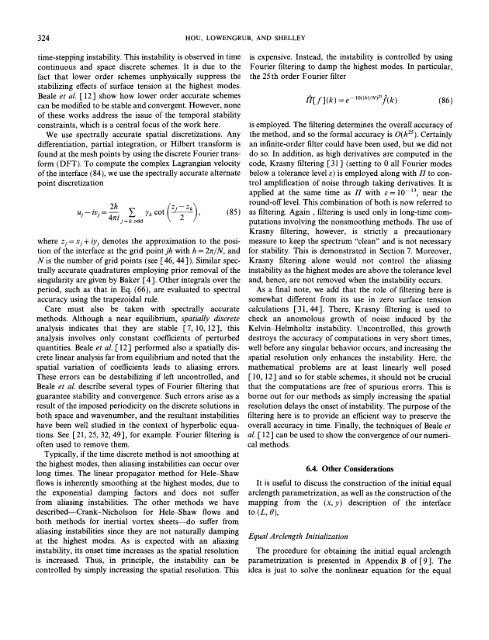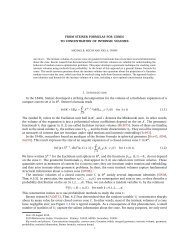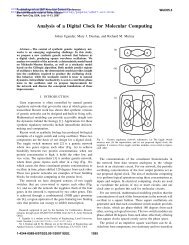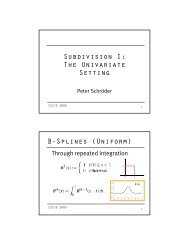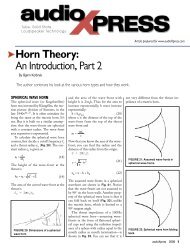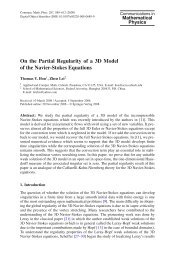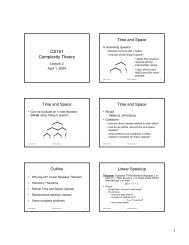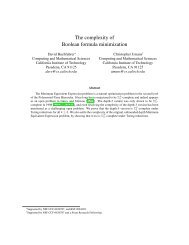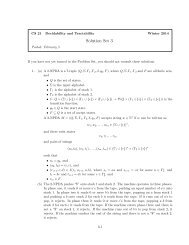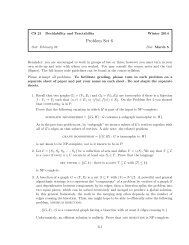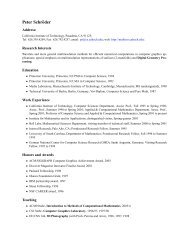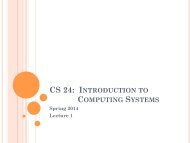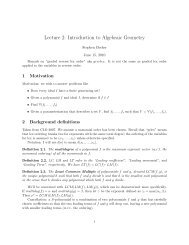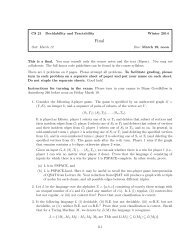Removing the Stiffness from Interfacial Flows with Surface Tension
Removing the Stiffness from Interfacial Flows with Surface Tension
Removing the Stiffness from Interfacial Flows with Surface Tension
You also want an ePaper? Increase the reach of your titles
YUMPU automatically turns print PDFs into web optimized ePapers that Google loves.
324 HOU, LOWENGRUB, AND SHELLEYtime-stepping instability. This instability is observed in timecontinuous and space discrete schemes. It is due to <strong>the</strong>fact that lower order schemes unphysically suppress <strong>the</strong>stabilizing effects of surface tension at <strong>the</strong> highest modes.Beale et al. [ 12] show how lower order accurate schemescan be modified to be stable and convergent. However, noneof <strong>the</strong>se works address <strong>the</strong> issue of <strong>the</strong> temporal stabilityconstraints, which is a central focus of <strong>the</strong> work here.We use spectrally accurate spatial discretizations. Anydifferentiation, partial integration, or Hilbert transform isfound at <strong>the</strong> mesh points by using <strong>the</strong> discrete Fourier transform(DFT). To compute <strong>the</strong> complex Lagrangian velocityof <strong>the</strong> interface (84), we use <strong>the</strong> spectrally accurate alternatepoint discretization-' --- ~ ykcot , (85)uj tVJ -- 4r~i j + k oddwhere zj-=-xj + iyj denotes <strong>the</strong> approximation to <strong>the</strong> positionof <strong>the</strong> interface at <strong>the</strong> grid point jh <strong>with</strong> h = 2zr/N, andN is <strong>the</strong> number of grid points (see [ 46, 44 ]). Similar spectrallyaccurate quadratures employing prior removal of <strong>the</strong>singularity are given by Baker [4]. O<strong>the</strong>r integrals over <strong>the</strong>period, such as that in Eq. (66), are evaluated to spectralaccuracy using <strong>the</strong> trapezoidal rule.Care must also be taken <strong>with</strong> spectrally accuratemethods. Although a near equilibrium, spatially discreteanalysis indicates that <strong>the</strong>y are stable [7, 10, 12], thisanalysis involves only constant coefficients of perturbedquantities. Beale et al. [ 12] performed also a spatially discretelinear analysis far <strong>from</strong> equilibrium and noted that <strong>the</strong>spatial variation of coefficients leads to aliasing errors.These errors can be destabilizing if left uncontrolled, andBeale et al. describe several types of Fourier filtering thatguarantee stability and convergence. Such errors arise as aresult of <strong>the</strong> imposed periodicity on <strong>the</strong> discrete solutions inboth space and wavenumber, and <strong>the</strong> resultant instabilitieshave been well studied in <strong>the</strong> context of hyperbolic equations.See [21, 25, 32, 49], for example. Fourier filtering isoften used to remove <strong>the</strong>m.Typically, if <strong>the</strong> time discrete method is not smoothing at<strong>the</strong> highest modes, <strong>the</strong>n aliasing instabilities can occur overlong times. The linear propagator method for Hele-Shawflows is inherently smoothing at <strong>the</strong> highest modes, due to<strong>the</strong> exponential damping factors and does not suffer<strong>from</strong> aliasing instabilities. The o<strong>the</strong>r methods we havedescribed--Crank-Nicholson for Hele-Shaw flows andboth methods for inertial vortex sheets-~lo suffer <strong>from</strong>aliasing instabilities since <strong>the</strong>y are not naturally dampingat <strong>the</strong> highest modes. As is expected <strong>with</strong> an aliasinginstability, its onset time increases as <strong>the</strong> spatial resolutionis increased. Thus, in principle, <strong>the</strong> instability can becontrolled by simply increasing <strong>the</strong> spatial resolution. Thisis expensive. Instead, <strong>the</strong> instability is controlled by usingFourier filtering to damp <strong>the</strong> highest modes. In particular,<strong>the</strong> 25 th order Fourier filter/~[f](k) -- e-1°(Ikr/u)25f(k) (86)is employed. The filtering determines <strong>the</strong> overall accuracy of<strong>the</strong> method, and so <strong>the</strong> formal accuracy is O(h25). Certainlyan infinite-order filter could have been used, but we did notdo so. In addition, as high derivatives are computed in <strong>the</strong>code, Krasny filtering [31 ] (setting to 0 all Fourier modesbelow a tolerance level e) is employed along <strong>with</strong>/7 to controlamplification of noise through taking derivatives. It isapplied at <strong>the</strong> same time as //<strong>with</strong> e= 10 -~3, near <strong>the</strong>round-off level. This combination of both is now referred toas filtering. Again, filtering is used only in long-time computationsinvolving <strong>the</strong> nonsmoothing methods. The use ofKrasny filtering, however, is strictly a precautionarymeasure to keep <strong>the</strong> spectrum "clean" and is not necessaryfor stability. This is demonstrated in Section 7. Moreover,Krasny filtering alone would not control <strong>the</strong> aliasinginstability as <strong>the</strong> highest modes are above <strong>the</strong> tolerance leveland, hence, are not removed when <strong>the</strong> instability occurs.As a final note, we add that <strong>the</strong> role of filtering here issomewhat different <strong>from</strong> its use in zero surface tensioncalculations [31, 44]. There, Krasny filtering is used tocheck an anomolous growth of noise induced by <strong>the</strong>Kelvin-Helmholtz instability. Uncontrolled, this growthdestroys <strong>the</strong> accuracy of computations in very short times,well before any singular behavior occurs, and increasing <strong>the</strong>spatial resolution only enhances <strong>the</strong> instability. Here, <strong>the</strong>ma<strong>the</strong>matical problems are at least linearly well posed[ 10, 12] and so for stable schemes, it should not be crucialthat <strong>the</strong> computations are free of spurious erorrs. This isborne out for our methods as simply increasing <strong>the</strong> spatialresolution delays <strong>the</strong> onset of instability. The purpose of <strong>the</strong>filtering here is to provide an efficient way to preserve <strong>the</strong>overall accuracy in time. Finally, <strong>the</strong> techniques of Beale etal. [ 12] can be used to show <strong>the</strong> convergence of our numericalmethods.6.4. O<strong>the</strong>r ConsiderationsIt is useful to discuss <strong>the</strong> construction of <strong>the</strong> initial equalarclength parametrization, as well as <strong>the</strong> construction of <strong>the</strong>mapping <strong>from</strong> <strong>the</strong> (x,y) description of <strong>the</strong> interfaceto (L, 0),Equal Arclength InitializationThe procedure for obtaining <strong>the</strong> initial equal arclengthparametrization is presented in Appendix B of [9]. Theidea is just to solve <strong>the</strong> nonlinear equation for <strong>the</strong> equal


